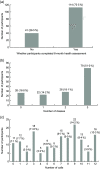Predictors of engagement and outcome achievement in a behavioural intervention targeting sugar-sweetened beverage intake among rural adults
- PMID: 31796129
- PMCID: PMC10200682
- DOI: 10.1017/S1368980019003392
Predictors of engagement and outcome achievement in a behavioural intervention targeting sugar-sweetened beverage intake among rural adults
Abstract
Objective: To describe relationships among baseline characteristics, engagement indicators and outcomes for rural participants enrolled in SIPsmartER, a behavioural intervention targeting sugar-sweetened beverage (SSB) intake.
Design: A secondary data analysis. Bivariate analyses determined relationships among baseline characteristics (e.g. age, gender, race, education, income), engagement indicators (completion of 6-month health screening, class attendance, call completion) and SSB outcomes (SSB ounce reduction (i.e. US fluid ounces; 1 US fl. oz = 29·57 ml), reduced ≥12 ounces, achieved ≤8 ounce intake). Generalized linear models tested for significant effects of baseline characteristics on engagement indicators and of baseline characteristics and engagement indicators on SSB outcomes.
Setting: South-west Virginia, USA, a rural, medically underserved region.
Participants: Participants' (n 155) mean age was 41 years; most were female (81 %), White (91 %) and earned ≤$US 20 000 per annum (61 %).
Results: All final models were significant. Engagement models predicted 12-17 % of variance, with age being a significant predictor in all three models. SSB outcome models explained 5-70 % of variance. Number of classes attended was a significant predictor of SSB ounce reduction (β = -6·12, P < 0·01). Baseline SSB intake significantly predicted SSB ounce reduction (β = -0·90, P < 0·001) and achieved ≤8 ounce intake (β = 0·98, P < 0·05).
Conclusions: The study identifies several participant baseline characteristics that may impact engagement in and outcomes from a community-based intervention targeting SSB intake. Findings suggest greater attendance of SIPsmartER classes is associated with greater reduction in overall SSB intake; yet engagement variables did not predict other outcomes. Findings will inform the future implementation of SIPsmartER and research studies of similar design and intent.
Keywords: Beverages; Completion; Health education; Rural communities; Treatment effectiveness.
Figures

Similar articles
-
Kids SIPsmartER reduces sugar-sweetened beverages among Appalachian middle-school students and their caregivers: a cluster randomized controlled trial.Int J Behav Nutr Phys Act. 2024 Apr 25;21(1):46. doi: 10.1186/s12966-024-01594-7. Int J Behav Nutr Phys Act. 2024. PMID: 38664715 Free PMC article. Clinical Trial.
-
Effects of a behavioral and health literacy intervention to reduce sugar-sweetened beverages: a randomized-controlled trial.Int J Behav Nutr Phys Act. 2016 Mar 22;13:38. doi: 10.1186/s12966-016-0362-1. Int J Behav Nutr Phys Act. 2016. PMID: 27000402 Free PMC article. Clinical Trial.
-
Association of a Workplace Sales Ban on Sugar-Sweetened Beverages With Employee Consumption of Sugar-Sweetened Beverages and Health.JAMA Intern Med. 2020 Jan 1;180(1):9-16. doi: 10.1001/jamainternmed.2019.4434. JAMA Intern Med. 2020. PMID: 31657840 Free PMC article.
-
Substituting sugar-sweetened beverages with water or milk is inversely associated with body fatness development from childhood to adolescence.Nutrition. 2015 Jan;31(1):38-44. doi: 10.1016/j.nut.2014.04.017. Epub 2014 May 9. Nutrition. 2015. PMID: 25441586 Review.
-
Comparative effectiveness of health literacy intervention on reducing sugar or sugar-sweetened beverage consumption in Asian populations: A systematic review.Public Health. 2025 Jul;244:105750. doi: 10.1016/j.puhe.2025.105750. Epub 2025 May 15. Public Health. 2025. PMID: 40378720
Cited by
-
Components in downstream health promotions to reduce sugar intake among adults: a systematic review.Nutr J. 2024 Jan 17;23(1):11. doi: 10.1186/s12937-023-00884-3. Nutr J. 2024. PMID: 38233923 Free PMC article.
-
Sociodemographic, Health, and Lifestyle-Related Characteristics Associated With the Commencement and Completion of a Web-Based Lifestyle Educational Program for People With Multiple Sclerosis: Randomized Controlled Trial.J Med Internet Res. 2024 Aug 28;26:e58253. doi: 10.2196/58253. J Med Internet Res. 2024. PMID: 39197163 Free PMC article. Clinical Trial.
-
Kids SIPsmartER reduces sugar-sweetened beverages among Appalachian middle-school students and their caregivers: a cluster randomized controlled trial.Int J Behav Nutr Phys Act. 2024 Apr 25;21(1):46. doi: 10.1186/s12966-024-01594-7. Int J Behav Nutr Phys Act. 2024. PMID: 38664715 Free PMC article. Clinical Trial.
-
Factors influencing engagement in in-person and remotely delivered lifestyle interventions for young adults with serious mental illness: A qualitative study.Early Interv Psychiatry. 2024 Jan;18(1):42-48. doi: 10.1111/eip.13432. Epub 2023 May 23. Early Interv Psychiatry. 2024. PMID: 37220910 Free PMC article.
-
Development of a Digital Behavioral Intervention to Reduce the Consumption of Sugar-Sweetened Beverages Among Rural Appalachian Adults: Multiphased, Human-Centered Design Approach.JMIR Hum Factors. 2023 Feb 1;10:e41262. doi: 10.2196/41262. JMIR Hum Factors. 2023. PMID: 36724036 Free PMC article.
References
-
- Nobles JD, Perez A, Skelton JA et al.. (2018) The engagement pathway: a conceptual framework of engagement-related terms in weight management. Obes Res Clin Pract 12, 133–138. - PubMed
-
- Stoutenberg M, Stanzilis K & Falcon A (2015) Translation of lifestyle modification programs focused on physical activity and dietary habits delivered in community settings. Int J Behav Med 22, 312–327. - PubMed
-
- Moroshko I, Brennan L & O’Brien P (2011) Predictors of dropout in weight loss interventions: a systematic review of the literature. Obes Rev 12, 912–934. - PubMed
Publication types
MeSH terms
Substances
Grants and funding
LinkOut - more resources
Full Text Sources
Miscellaneous

